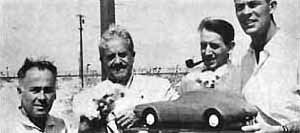| It's 1961 and the Studebaker Corporation is a faltering giant. |
| In February, Sherwood Egbert is hired as the President and takes over the helm at the Studebaker Corporation. He came there from the McCulloch Motors Corporation with no experience in the automobile industry. He replaced former president Harold E. Churchill under a corporate goal of diversification, to get the company out of carmaking and "absorb Studebaker's tax loss credits ($94 million) by merging with prosperous companies". ///He was perfectly content to proceed with diversification as ordered, but he was equally determined to find some way to save the Studebaker car/[4]/ [1] [4]Av123 |
| March 9th 1961, Sherwood Egbert contacts Raymond Loewy and asked him to design a new car for Studebaker. Flying to California to meet Loewy, Egbert roughed out a small sketch. "I knew at once," says Loewy, "that we were on the same wave length." |
|
Loewy agreed to take the job. He recruits a team consisting of experienced designers
including former Loewy employees
John Ebstein, Bob Andrews, and Tom Kellogg, a young student from Art Center College of Design in Pasadena. Within ten days Raymond Loewy, John Ebstein, Thomas Kellogg and Robert Andrews were all working at a rented house in Palm Springs. Each team member had a role: Andrews and Kellogg handled sketching, Ebstein oversaw the project, and Loewy was the creative director and offered advice.

|
|
By March 27, a mere eight days after design work began, they had created a 1/8th size clay scale model with two different sides: one a two-seat sports car, the other a four-seat GT coupe. On April 2nd, Egbert flew out to Palm Springs to view the final clay model and the final drawings. With only a few minor changes, he toasted the new car with a soft drink, and said, "Let's go!" By April 27th 1962, the full-sized clay model was done, just five weeks after development began. The scaled clay model was shipped back to South Bend Indiana for Robert Doehler and the Studebaker styling crew. Egbert settled on the four-passenger, 2-door idea. The windsheild pillar was made more upright when Egbert bumped his head while getting into the seating buck. The "Coke bottle" shape was moderated. The assymetrical hood bump was borrowed from some of Loewys early sketches for the Avanti. The taillights were modified to make them easier to produce. Finally, the quad-headlights were changed to single headlights to reduce cost. Bob Doehler and the styling crew create a full sized clay model incorporating the changes. In late April, the Studebaker Board of Directors were given a presentation of the new car and they gave the go-ahead to prepare it for production.
|
|
|
